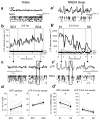Local sleep in awake rats
- PMID: 21525926
- PMCID: PMC3085007
- DOI: 10.1038/nature10009
Local sleep in awake rats
Abstract
In an awake state, neurons in the cerebral cortex fire irregularly and electroencephalogram (EEG) recordings display low-amplitude, high-frequency fluctuations. During sleep, neurons oscillate between 'on' periods, when they fire as in an awake brain, and 'off' periods, when they stop firing altogether and the EEG displays high-amplitude slow waves. However, what happens to neuronal firing after a long period of being awake is not known. Here we show that in freely behaving rats after a long period in an awake state, cortical neurons can go briefly 'offline' as in sleep, accompanied by slow waves in the local EEG. Neurons often go offline in one cortical area but not in another, and during these periods of 'local sleep', the incidence of which increases with the duration of the awake state, rats are active and display an 'awake' EEG. However, they are progressively impaired in a sugar pellet reaching task. Thus, although both the EEG and behaviour indicate wakefulness, local populations of neurons in the cortex may be falling asleep, with negative consequences for performance.
Conflict of interest statement
COI statement: All authors indicated no financial conflicts of interest.
Figures



Comment in
-
Neuroscience: Sleepy neurons?Nature. 2011 Apr 28;472(7344):427-8. doi: 10.1038/472427a. Nature. 2011. PMID: 21525924 No abstract available.
-
Sleep: Neurons take a nap.Nat Rev Neurosci. 2011 Jun;12(6):305. doi: 10.1038/nrn3048. Epub 2011 May 18. Nat Rev Neurosci. 2011. PMID: 21587286 No abstract available.
References
-
- Steriade M, Timofeev I, Grenier F. Natural waking and sleep states: a view from inside neocortical neurons. J Neurophysiol. 2001;85(5):1969–1985. - PubMed
-
- Dijk DJ, Duffy JF, Czeisler CA. Circadian and sleep/wake dependent aspects of subjective alertness and cognitive performance. J Sleep Res. 1992;1(2):112–117. - PubMed
-
- Van Dongen HP, Maislin G, Mullington JM, Dinges DF. The cumulative cost of additional wakefulness: dose-response effects on neurobehavioral functions and sleep physiology from chronic sleep restriction and total sleep deprivation. Sleep. 2003;26(2):117–126. - PubMed
-
- Borbély AA, Achermann P. Sleep homeostasis and models of sleep regulation. In: Kryger MH, Roth T, Dement WC, editors. Principles and Practice of Sleep Medicine. W. B. Saunders; Philadelphia: 2005. pp. 405–417.
Publication types
MeSH terms
Grants and funding
LinkOut - more resources
Full Text Sources
Other Literature Sources

